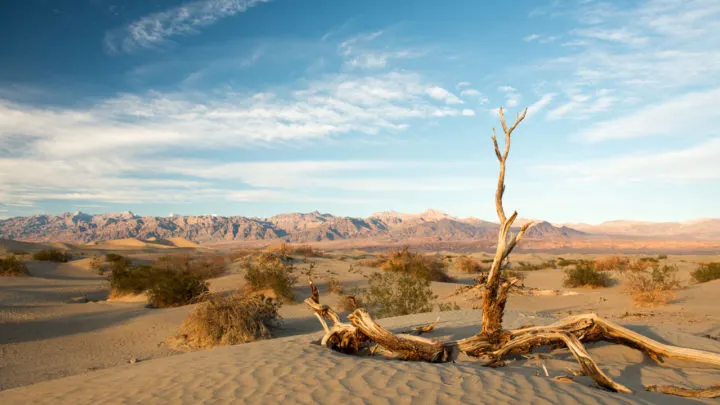Welcome to what seems like one of the most desolate places on Earth. Be prepared to be in awe, to gaze into vast spaces in wonder, and feel like you’re on another planet. This national park is nothing short of spectacular and no matter how much time you have to visit, you will leave thoroughly impressed with what you’ve seen.
But before embarking on your adventure, be mindful of how extreme Death Valley is. Be prepared not just with where to stay and go, but practice safety by knowing what time of year to go, where to avoid, and more.
By the end of this Death Valley National Park travel guide you will have all the need-to-know details to take off on your next great adventure. Enjoy!
Places to Go
While Death Valley offers more than just these places to go, these are undoubtedly the top places to visit with a few worth considering adding to your itinerary.
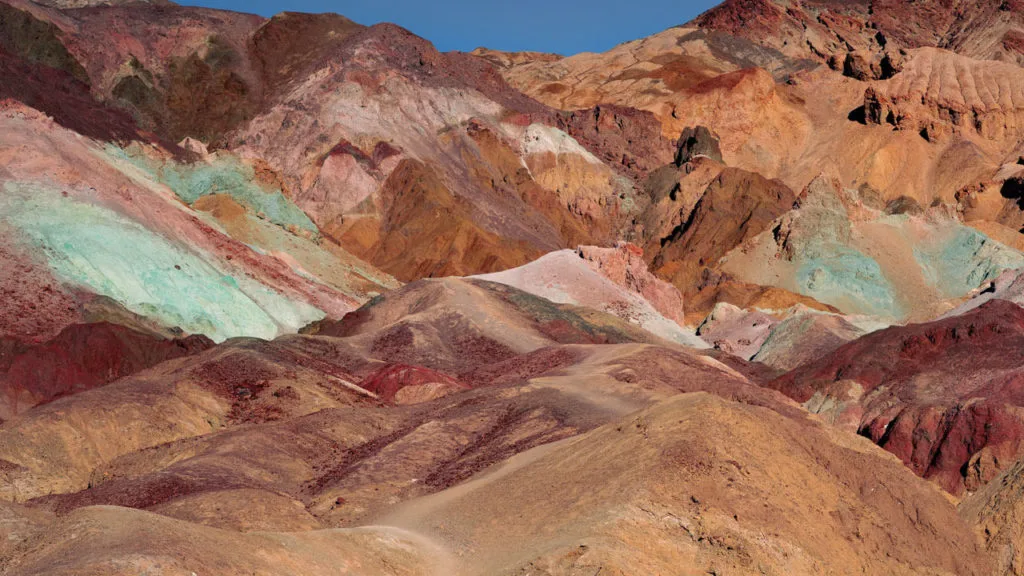
Artists Palette
Artists Palette is no doubt one of the best highlights of this national park. This natural spot puts on a show with an array of colors that are from oxidized minerals. Make your way onto the one-way Artists Drive Scenic Loop for 9-miles of spectacular scenery that looks almost unnatural. Opt to go for sunrise or sunset to see the colors truly pop, and pull over into one of the designated areas to go for for a little wander into the hills.
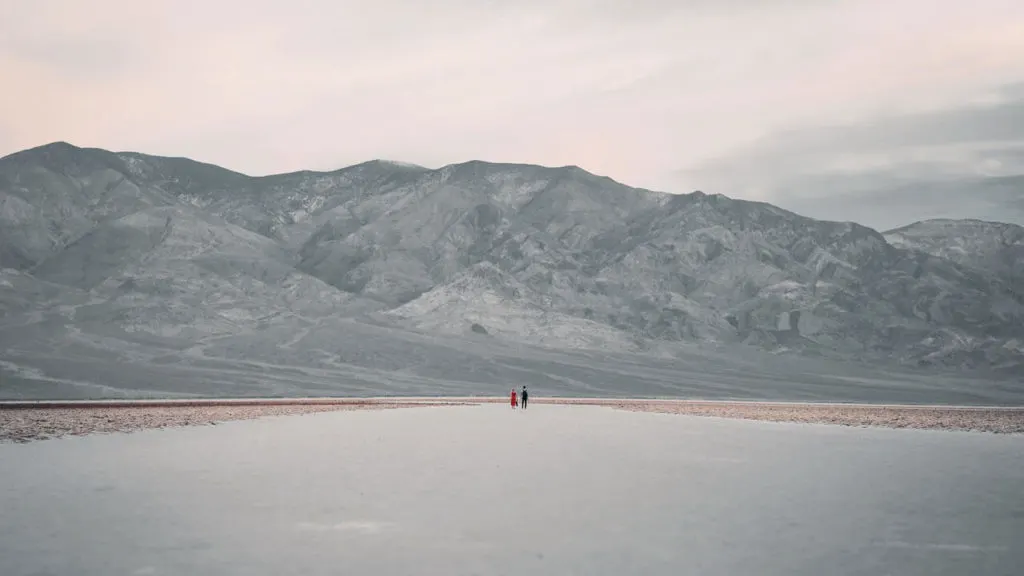
Badwater Basin
Spanning almost 200 square miles (518 square km), this sight in the park seems to go on forever. Far from boring, here you can walk out into the salt flats that are the lowest place in North America. Opt for a short hike out into the vast area (careful not to go too far in the heat) and you’ll be in for a treat to see the Black Mountains and Telescope Peak, where you’ll witness the closest vertical range at such a distance in North America. Once ancient Lake Manly which evaporated tens of thousands of years ago, today the salt flats are made of mostly that, table salt!
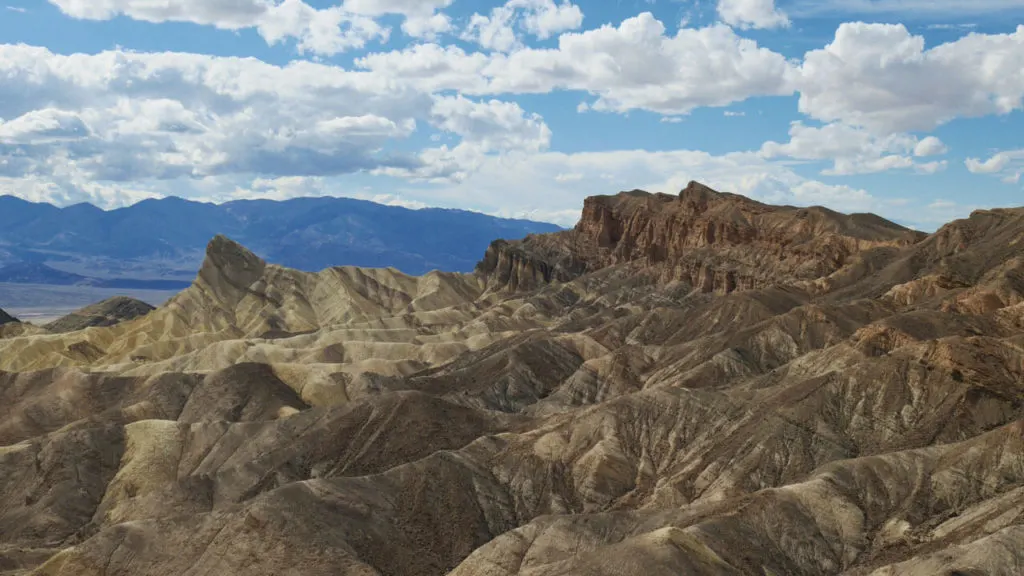
Zabriskie Point
An awesome spot for sunset or sunrise viewing in Death Valley? Check. Head to Zabriskie Point, even at any time of the day for a view that will pull you in. Overlooking the badlands, you can see first-hand how the water shaped the land that is still evident today. Look further and you’ll even spot the salt flats with the unmistakable Panamint Mountains as the backdrop. Manly Beacon is the most obvious part of this park highlight, which was named after one of the gold rush pioneers of the area.
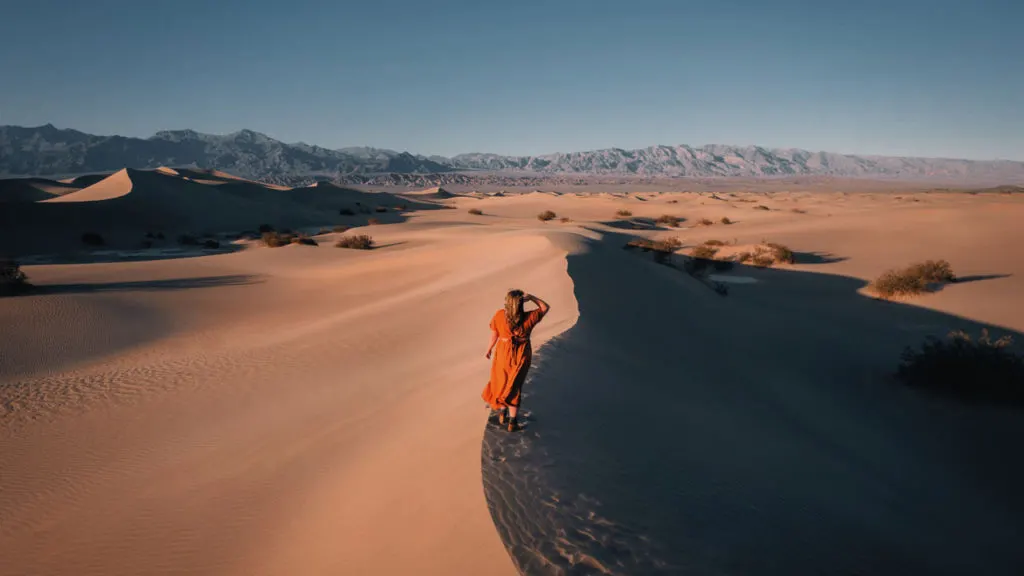
Mesquite Flat Sand Dunes
You’d think that in an area as dry as Death Valley there would be an abundance of sand, but few places have enough to make the cool dunes that many love to see and explore. These dunes are named after the mesquite trees that grow in the area, surviving the constantly shifting sand by twisting as they grow. Come in the spring to see the trees bloom with yellow and green flowers decorating them. Like many other spots in the park, sunset and sunrise here are pretty amazing, and it’s also a top spot for night sky viewing.
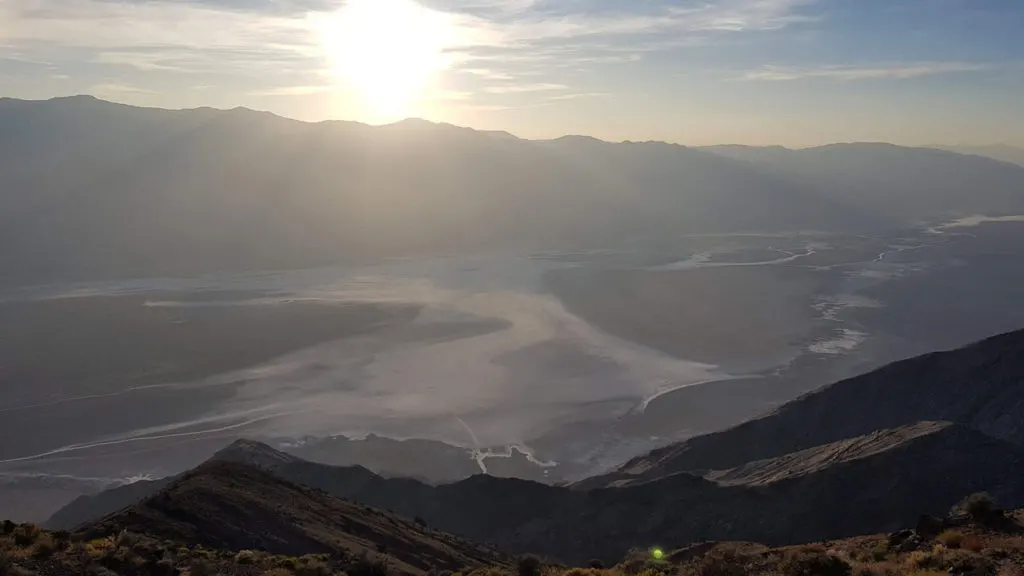
Dantes View
Spectacular anytime of the day, but also for sunrise, sunset, and even at night, Dantes View is a spot that will have you wanting to stay for longer. Far from just a haven for photographers and Instagrammers alike, here you can also hike along the ridge, where even on days with the busiest of crowds you’ll be able to find some space to yourself. Here on the Black Mountains, you’ll have towering views over Badwater Basin from a completely different, and must-see perspective.
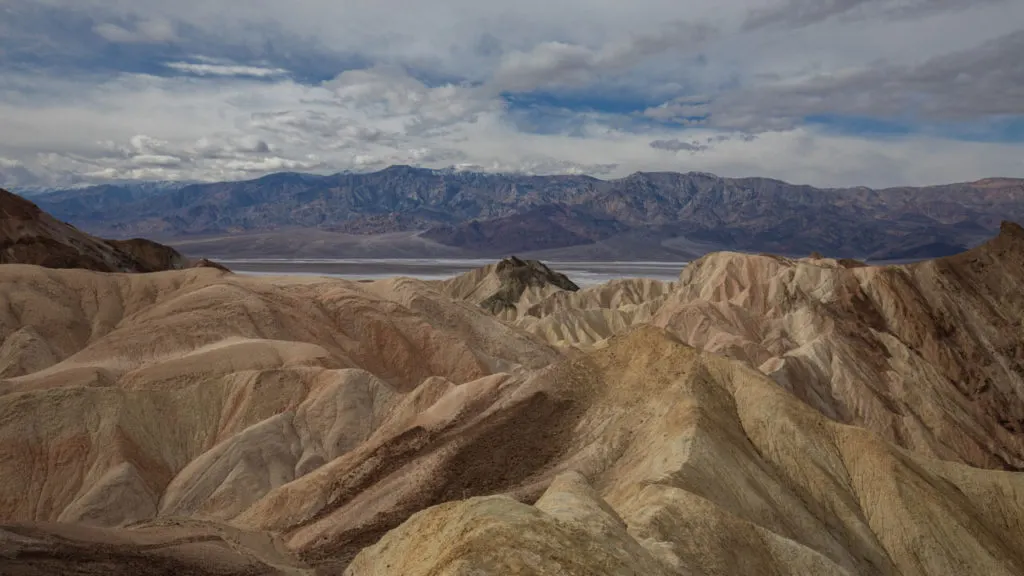
Golden Canyon
Make sure your visit includes a visit to one of the canyons in this national park. Golden Canyon is one of the more popular canyons and for a good reason. It’s here that you’ll get to witness some of the unique geology of the park and rock formations painted in yellow and red. Add in the hike of Gower Gulch loop to magnificent views of Badwater Basin and Zabriskie Point.
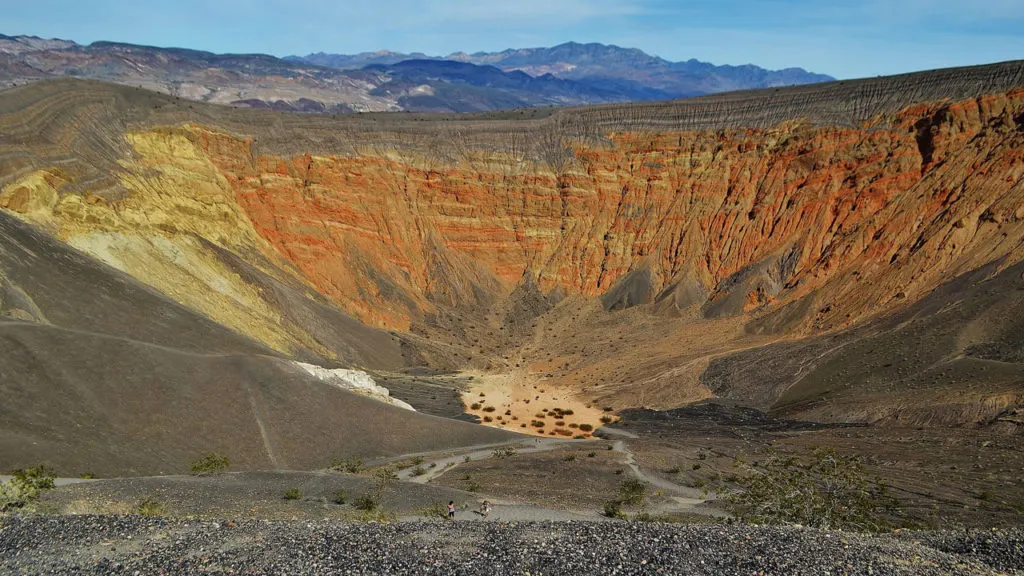
Ubehebe Crater
Nature at its wildest, Ubehebe Crater is just one of a dozen or so craters in the area, but this one is the largest and the youngest. The crater was created by lava touching water on the ground which created an explosion which today you can hike, a short 1.5 miles (2.4km) around the rim. Alternatively, you can visit and hike down into Little Hebe Crater, but be mindful of how difficult it is to hike back up and to not do it during hot temperatures.
Wildrose Charcoal Kilns
For a spot of something different amongst nature, head out on a detour to the charcoal kilns in Wildrose Canyon. The kilns were used for charcoal for the mines close by, but they stopped being used in 1879, most likely. Today the drive to this part of the park will deliver exceptional views in an area where fewer venture.
Things to Do
This national park has all of the usual things to do, plus more. Let this unworldly area surprise you, there’s more than meets the eye!
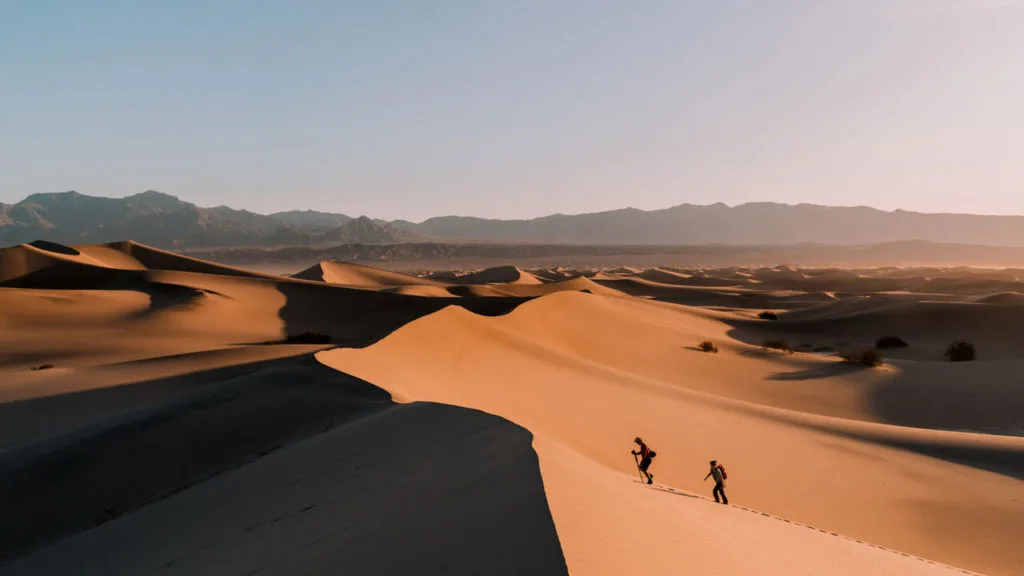
Hiking
Hikes in Death Valley are abundant, and while a place as empty as this park may not seem like you need a trail (many don’t), there are also trails to follow along, in canyons, and more. Hiking is available for all levels with beginner to advanced trails guiding you through other-worldly terrain. Trails begin at just 0.4 miles (0.6km) and range in length to 14 miles (22.5km).
Some trails are more accessible than others, with some offering boardwalks, bathrooms, and paved roads, others not. The most important thing to keep in mind is your safety when hiking. It’s best to avoid the lower elevation hikes in the summer altogether and stick to the higher elevation ones. But in the winter be mindful of having the right equipment for hiking on snow in higher elevations. Always have enough water with you. You can find all the need-to-know details for hiking in Death Valley here.
Sightseeing
No matter how long you’re visiting Death Valley for, you will be able to fit in multiple sights that are all worth seeing. Artists Palette is perhaps the most popular, along with Badwater Basin, and Zabriskie Point. The Mesquite Flat Sand Dunes and Dante’s View, along with what was previously listed can all be visited in a day. Ubehebe Crater and Rainbow Canyon are also great for sightseeing but are best for longer itineraries. All of these sightseeing destinations in this park you can drive to.
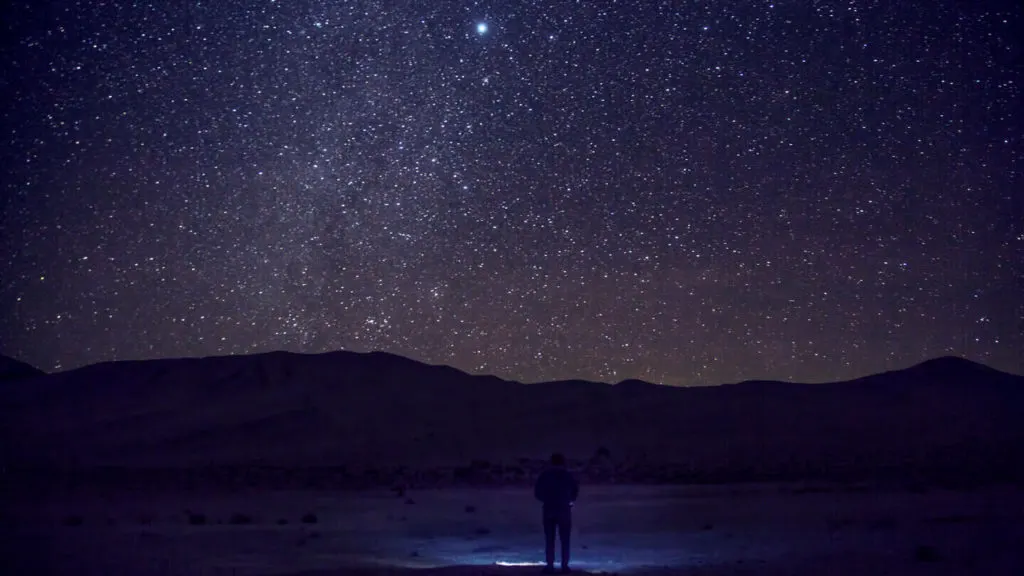
Night Sky Viewing
Death Valley is one of the best places in the world to see stars, planets, and more that can’t be seen in most places. This park is so dark at night that it’s easy to find a place to star, or Milky Way gaze, anywhere away from a campground or road and is actually a Gold Tier level (the highest) for a dark sky. Since Death Valley doesn’t have a park closing time you’re welcome to venture to any spot in the park to take in the spectacular views!
Guided Tours
A great way to see and understand more of the extremes of this park is to join a ranger-led tour. The programs include a mix of talks, walks, and hikes in areas such as Badwater Basin, Harmony Borax Works, a night sky talk, a sunset hike at the dunes, and even a flintknapping demonstration (making tools from stone). Additionally, you can also join a paleontology hike to a remote part of the park to see tracks that are fossilized. Reservations are needed as it’s small groups only and a small $1 ticket fee must be purchased.
Last, but not least, you can do your own self-guided Star Wars driving tour! Star Wars A New Hope and Return of the Jedi were both filmed in the park before more strict filming regulations were placed on filming in wilderness areas. The tour, which you can find on this app, will take you to some of the best parts of the park too.
Keep in mind that ranger-led programs are only available from December to March. Find the most up-to-date details at the Furnace Creek Visitor Center.
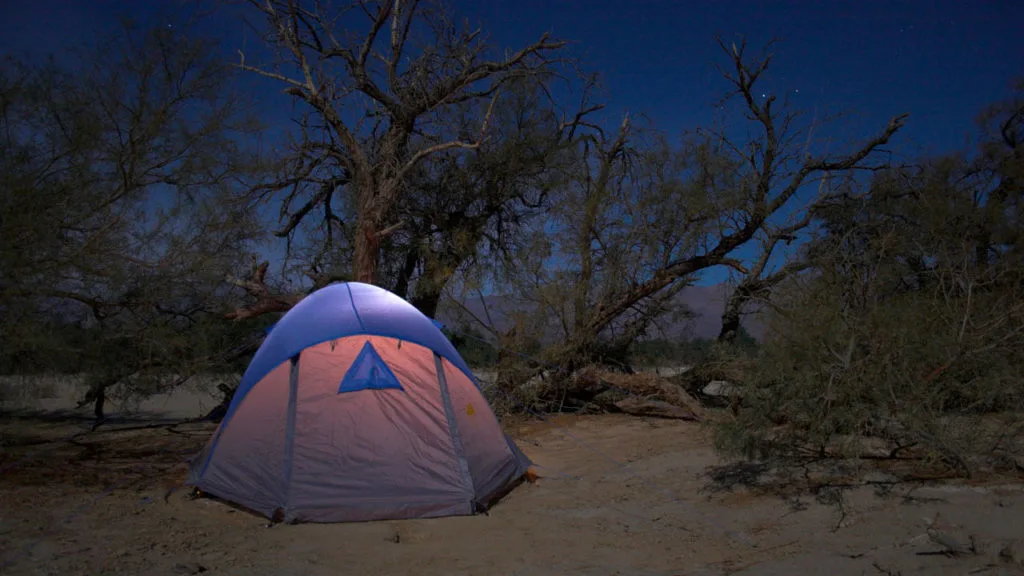
Camping
Camping, even despite the terrain of this national park, is quite a popular activity. The best part about camping in Death Valley is that only one campground requires reservations! Furnace Creek campground requires reservations, which can be made from October 15th-April 15th, with no reservations required in the summer.
All other campgrounds in the park do not require reservations and range for times when they’re open. Some are open late fall until spring, some are only spring through until the fall, a few are open year-round. All but Furnace Creek are on a first-come-first-serve basis with most having flush toilets and only Furnace Creek having hookups. A few are even free, but for those that require payment you can pay at the pay stations at the campsite. Find all the need-to-know camping details here.
Backcountry Driving
Did you know that Death Valley has more roads (paved and dirt) than any other national park in the country? Talk about a great place for a road trip! Since most car rentals require you to only drive on paved roads, Farabee Rentals is a great spot to get an off-roading vehicle close by. Keep in mind you must stay on designated roads, but it’s a great place to truly be surrounded by nature at its most extreme.
Other Things to Do in Death Valley
- Backpacking
- Trailrunning
- Mountain biking
Best Time to Visit Death Valley National Park
If there’s one time to avoid visiting Death Valley, it’s in the summer. As the hottest place on Earth, summer brings pretty brutal temperatures. That being said, people still visit. The most popular time to visit is spring (March-May) when, if it was rainy over the winter, spring followers will dot the area.
The best time to visit with the least amount of visitors is also a time with cooler weather, the fall (October-November), which is also when ranger programs begin. Winter will bring cooler temperatures even and the mountain peaks to be dusted with snow.
How many days do you need in Death Valley?
A weekend in Death Valley is a great amount of time, whether it’s extended or not. While many will do a Death Valley day trip and you can see plenty in a day, 2 days in the park is ideal, with 3 days providing you with more leisure time and perhaps fewer crowds.
Park Permits
Death Valley is not free to enter. This national park does require that you purchase a park pass which you can buy online or in-person at one of the visitor centers. Park passes are available for vehicles, motorcycles, and for those entering on foot and are valid for 7 days from the date of purchase with re-entry permitted. An annual pass is also available. More park pass and permit info, including where you can purchase can be found here.
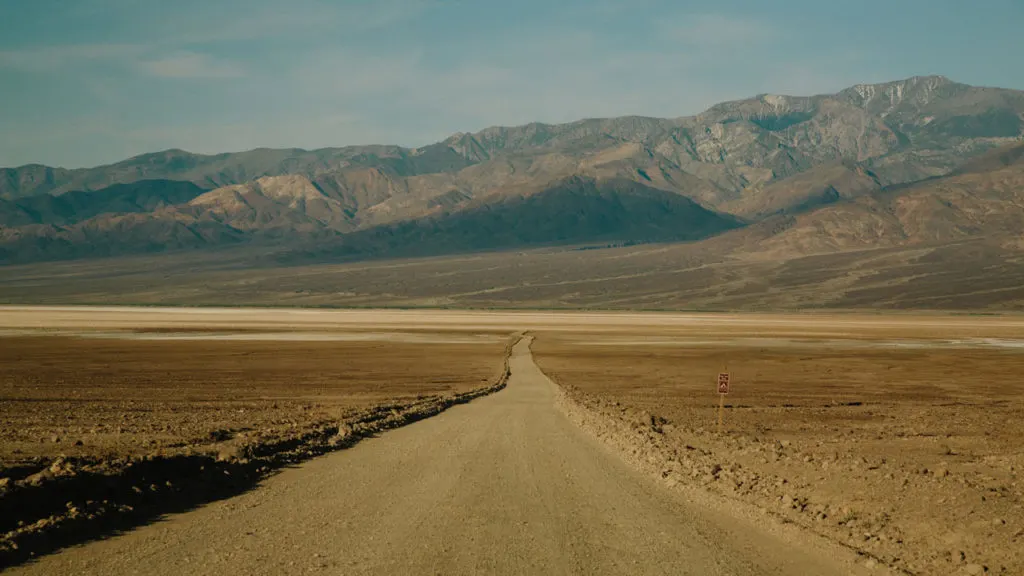
Where to Stay
Accommodation is available both inside and outside of the park, but some places are a fair distance. I have a full guide on the best areas to stay for all types of travelers. Camping is also available in the park, with some spots completely free, others are paid, most on a first-come-first-serve basis.
Furnace Creek
Furnace Creek is located inside the park and is most likely where you’ll want to stay if you’re looking to do multiple days in the park, are short on time, and want to have minimal distances to drive.
- The Inn at Death Valley: A luxurious stay right inside the park is a great way to relax after a day in nature.
- The Ranch at Death Valley: A 4-star hotel with mountain views that is great for all, including groups, with a restaurant on-site as well.
- Amargosa Opera House & Hotel: Just a 15-minute drive outside of the park, this hotel is a great budget option.
How to Get to Death Valley
Travel by car is really the only option for getting to and around Death Valley. You have a few options from major cities to get here.
Los Angeles
From Los Angeles to Death Valley, or more specifically from LAX to Furnace Creek, it is a 5-hour drive. That doesn’t have to be done all in one go though. Some stops you can add to your road trip could be Red Rock Canyon State Park (via Highway 15), Trona Pinnacles, or Ballarat Ghost Town (both via Highway 190).
Or, you could also detour to Joshua Tree National Park for 1-2 days, which is highly recommended.
San Francisco
From San Francisco to Death Valley it will take you approximately 8 hours driving via Highway 99. While this road trip is long, there are many amazing stops you can make between these two destinations. A great detour is through Yosemite National Park (Highway 120), which you will need a park pass for. Be mindful that the Tioga Pass to access Highway 395 is closed in winter, but you can always drive through South Lake Tahoe instead. A highway 395 road trip is highly recommended as well as it’s one of the most scenic road trips in California.
Las Vegas
Las Vegas is the closest major city to Death Valley and it’s also where the closest airport is. In just 2 hours driving you can make your way from Las Vegas to Death Valley, with a few options for stops. While it may be a bit of driving in a day, Death Valley can also be visited as a day trip from Las Vegas.
Travel through Amargosa Valley on the US-95 to make a pit stop at Area 51 or opt to continue north to go through Beatty where you can stop in Rhyolite Ghost Town near the north end of the park which is also close to Ubehebe Crater. Alternatively, take the NV-160 through Pahrump and Death Valley junction which is slightly shorter.
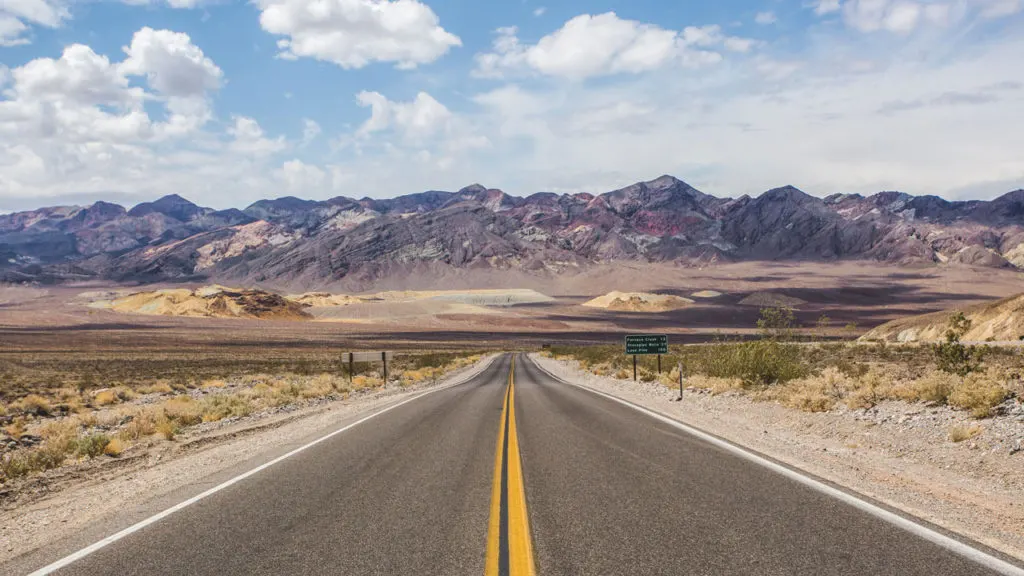
Driving in Death Valley
All of the major highlights in Death Valley you can get to with a car. Some roads will turn to gravel and some do have restrictions to be mindful of as some roads are recommended for 4×4 vehicles only. That being said, you shouldn’t run into issues but you can also check the NPS website for the park map and driving details. All you need to know is that driving is safe in Death Valley with a regular car.
Gas & Cell Service
While there are three places to get gas in the park, they are small gas stations and it’s not unheard of for them to run out of gas. The three stations are:
- Furnace Creek (premium & diesel are only available here)
- Stovepipe Wells Village
- Panamint Springs
All of the towns before entering the park of course have gas stations, so fill up before. These include Lone Pine, Ridgecrest, Pahrump, Beatty, and others.
Cell service is spotty at best so be sure to download any hiking trail maps (I recommend AllTrails) and driving directions before entering the park. Do NOT rely on your car’s navigation system when driving in Death Valley, especially for backcountry driving.
Death Valley FAQs
This California park is famous because it’s so extreme. It is the hottest, driest, and lowest national park and is where you can see snow-capped mountains but also dry land scorched by the heat at the same time. It also holds the record for the hottest temperature ever recorded, 134°F (56.7°C).
The story goes that some of the Lost ’49ers, those on a mission to find gold back in the day, were attempting to cross the Panamint Range but were unable to so they made their way to the valley floor. Two men who were sent in a different direction to get more supplies returned much later to find some of the people still waiting in the harsh conditions, where one had died. It’s said that upon leaving, someone turned around and said “Goodbye, Death Valley.”

